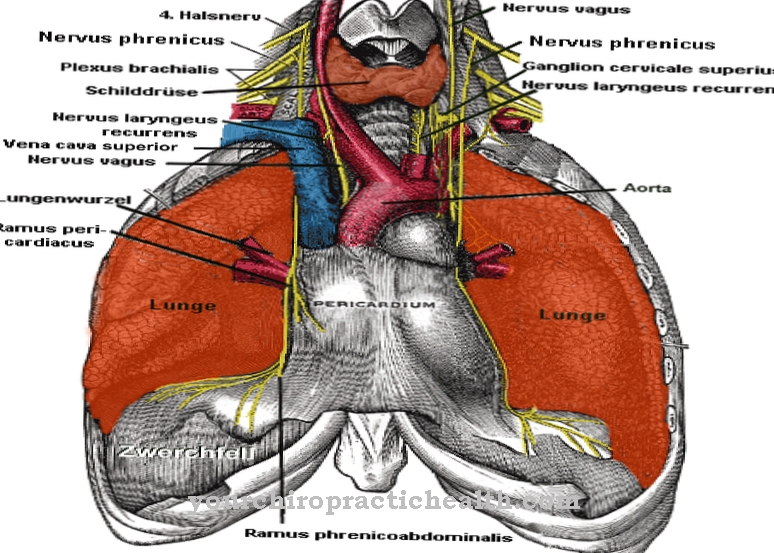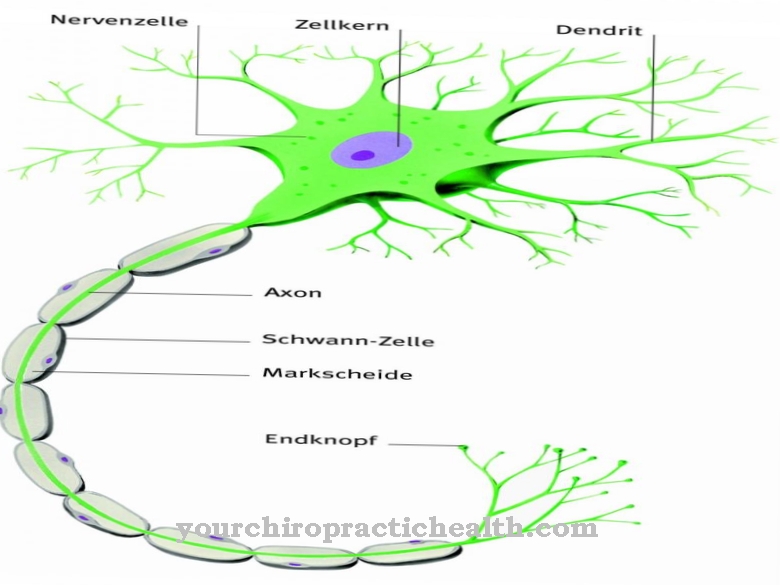Of the Sinus node is the electrical clock generator of the heart, which is responsible for the generation of excitation and the heart rate. A pacemaker cell can discharge itself, which is why it dictates the heart rhythm. A malfunction of the sinus node slows the heartbeat, and a pacemaker can then take over.
What is the sinus node?
Of the Sinus node (SA node, Keith Flack Knot or Nodus sinuatrialis) is located in the right atrium and is responsible for the sinus rhythm. It is also known as the heart's stimulus center. Electrical excitation is transmitted through depolarization, which determines the heart's rhythm.The SA node is spindle-shaped on the epicardium (outer layer of the heart wall), the size of the node often differing considerably (width 2 to 3 mm, length 10 to 20 mm). It consists of heart muscle cells that can spontaneously depolarize, creating an electrical excitation. From the sinus node, three fiber bundles go in the direction of the atrioventricular node:
- Bachmann-James bundle (anterior internodal bundle)
- Wenckebach bundle (middle internodal bundle)
- Thorel bundle (posterior internodal bundle)
Anatomy & structure
The heart pumps independently and is not dependent on nerve excitation. This is due to the fact that there are so-called pacemakers here. These cells discharge spontaneously, the most important clock being the sinus node. It is located on the outermost layer of the heart muscle, where the superior vena cava flows into the right atrium. It is a lump that cannot be felt and is supplied with blood by the right coronary artery.
In healthy people it reaches a frequency of about 70 beats / minute. However, this number depends on age, the level of training and various individual factors. During physical exertion, the frequency increases to 120 beats, often up to 200 beats. During the night the frequency is then only 50 beats per minute.
Function & tasks
The sinus node is also known as the autonomous pacemaker, which creates the excitation of the heart. For this purpose, sodium ions flow into the cells and calcium channels open, which leads to the excitation of the SA node. If a certain threshold value is reached, the cell is completely discharged (depolarization). Then the tension is balanced, the particles are concentrated again by the sodium-potassium pump and the initial position is restored (repolarization).
The electrical curve that this creates is called the action potential. The excitation of the sinus node then continues to the atrioventricular node, which is located between the ventricles and the atria. The atrioventricular node forwards the signals from the sinus node to what is known as the bundle of His, which moves in the direction of the ventricular septum. There the excitation line divides into a left or right chamber limb. The ventricular limbs then branch out at the apex of the heart, the end branches being called Purkinje fibers.
Illnesses & ailments
The sinus node can be affected by various disorders, which are summarized under the term "sick sinus syndrome". This includes changes in frequency of various kinds: If the frequency is too slow, it is called bradycardia, if it is too fast, it is known as tachycardia.
Another variant is sinus arrest. The sinus node fails completely and an acute cardiac arrest occurs. Normally the atrioventricular node steps in here, which then takes over the function of the sinus node, but it works with a slightly lower frequency. However, this is sufficient, so that sinus arrest is life-threatening only in rare cases.
In addition, phases of increased arousal can alternate with phases in which the number of beats is reduced. The rapid phases are then also known as atrial fibrillation or atrial flutter. Sinus node syndrome is more common in patients who have coronary artery disease or high blood pressure, which means that the heart muscle is not supplied with sufficient oxygen.
Depending on the heart rate, a wide variety of symptoms arise: If the heart rate is less than 50 per minute, those affected suffer from dizziness or fainting spells, if the heart rhythm is permanently slowed down, there is shortness of breath, reduced performance or water retention in the legs and lungs.
Patients also complain of frequent urination at night and the inability to lie flat in bed. Overactivity manifests itself in breathing difficulties, feelings of tightness in the chest or palpitations. Pain occurs in the chest, which also radiates to the left arm or neck and can be very threatening.
If the heart rate does not increase during physical exertion, one speaks of a chronotropic incompetence. If the electrical impulses from the SA node are no longer passed on to the ventricle, an AV block occurs, whereby three different forms can be distinguished:
- First-degree AV block: This is where the transmission of impulses is delayed. However, this form does not normally require treatment.
- Second degree atrioventricular block: The transmission of the signals fails from time to time. Treatment should be considered if heart disease is present.
- Third-degree AV block: The conduction is completely interrupted and typical symptoms of bradycardia occur.
The doctor diagnoses a disturbance of the excitation conduction with the help of an EKG. A long-term ECG may also be required, with the device being worn on the body for one day. The diseases are treated with the help of medication or the use of a pacemaker.













.jpg)

.jpg)
.jpg)











.jpg)